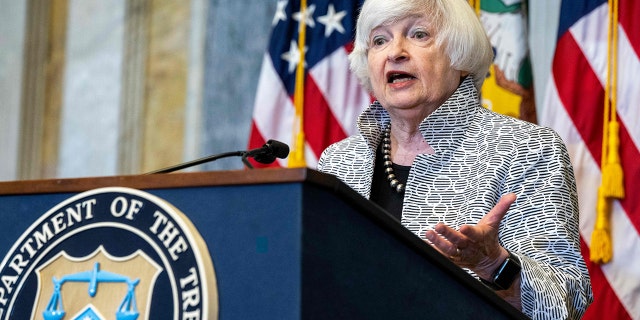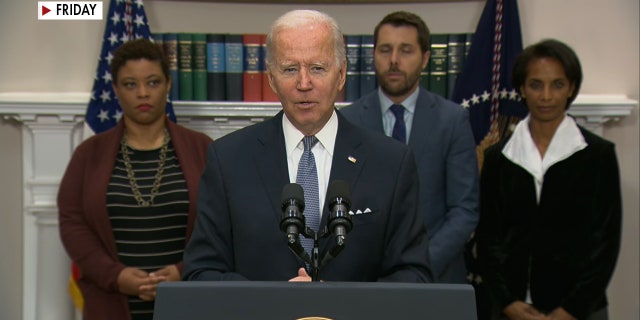President Joe Biden announced the first major release from the Strategic Petroleum Reserve (SPR) on Nov. 23, 2021. He said the recovery from the coronavirus pandemic was increasing demand for gasoline as the world reopened and supply wasn’t keeping up. The weekly average price for regular gasoline was $3.40 per gallon – more than a dollar increase from the same time period in 2020.
“It’s always painful when gas prices spike,” Biden said. “The fact is we always get through those spikes. But we’re going to get through this one as well and, hopefully, faster.”
The 50 million barrel sale was the largest in history. The release happened gradually over time, but more than three months later, the average gas price was 20 cents higher and the Biden administration announced another 30 million barrel release.
Fox News White House correspondent Jacqui Heinrich pressed then-White House press secretary Jen Psaki on the effectiveness of the releases during a March 3, 2022, press briefing.
“What this is a reminder of, in the president’s view, is our need to reduce our reliance on oil,” Psaki said.
President Biden announced the first major release from the Strategic Petroleum Reserve on November 23, 2021. (AP Photo/Cedar Attanasio, File)
By the end of March 2022 gas prices rose once again – to more than $4 per gallon. The administration responded by releasing more oil.
“Putin’s price hike is hitting Americans at the pump,” Biden said during the announcement. His plan authorized the release of 1 million barrels of oil per day – for the next six months. More than 180 million total would be released from the reserve.
“So, one of the one of the free-market perspectives on the SPR is that there’s a danger in dumping a lot of oil all at once for fear that you will crowd out investment that otherwise might have come to market,” Managing Director of Clearview Energy Partners Kevin Book said. “For a politician, there’s no question what you do. You don’t have a lot of voters who are going to celebrate high prices.”
BIDEN APPEARS TO GO OFF SCRIPT TO SAY US NEEDS OIL, GAS DRILLING
Gas prices peaked at more than $5 per gallon in June 2022 before eventually falling to below $4 in August – a little more than two months away from the November election.
“If there had been an election or not, I think President Biden would have gone to the Strategic Petroleum Reserve,” Rep. Kathy Castor, D-Fla., said. “You don’t want to do it for purely political purposes. And President Biden didn’t do that. In this case here, we had the unprovoked war of aggression by Vladimir Putin on the innocent people of Ukraine. And I think that was entirely appropriate at that point to tap the SPR.”
Lawmakers are at odds over whether the coronavirus pandemic and the war in Ukraine warranted the significant drawdown.
“We need to make sure that that is here for emergencies only,” said Sen. John Barrasso, R-Wyo. “We’re at a point of maximum vulnerability. That’s a problem when we’re part of the action of this president who took so much out. Not because we had an emergency, it was because he panicked politically when gas was at $5 a gallon.”
The reserve has less than 372 million barrels remaining. The maximum total withdrawal capability from the SPR is only 4.4 million barrels per day. So, if we had to rely on the stockpile, we would have enough supply for just 85 days.
“We’re at the lowest levels in the Strategic Petroleum Reserve in 40 years,” American Petroleum Institute Vice President Frank Macchiarola said. “That sends a signal to the marketplace that if there is a meaningful and significant supply disruption, there’s questions about whether we’ll have the capacity to be able to fill the market with product.”
More oil will be released from the reserve this year. The Energy Department announced that 26 million barrels will hit the market as part of a requirement in the 2018 budget deal. The sales were mandated to help fund the government. Congress canceled additional required releases from 2024 through 2027. Those would have sunk the stockpile to around 200 million barrels if no oil was added back.
The Treasury Department and Clearview Energy Partners estimate U.S. gas prices did fall during the drawdown. Book notes the decrease was not significant but the Ukraine war may have prevented prices from falling further.
“These are not fly-to-the-moon numbers. Between March and December, our numbers at Clearview are that we see about $0.25 a gallon of impact,” Book said. “That $0.25 a gallon is in addition to everything else that was going on.”

Treasury Secretary Janet Yellen (SAUL LOEB/AFP via Getty Images)
Macchiarola said the SPR release had limited impact on the overall global price of oil.
“When coming out of COVID, we had a significant increase in demand for oil, and supplies did not keep pace. And so we had a volatile market. We had prices go up,” Macchiarola said. “Compounding that was a lot of concerns around the unrest in Ukraine.”
Book warns that Russia is creating even more uncertainty with limitations to its oil production. Deputy Prime Minister Alexander Novak announced Friday that the Kremlin would cut 500,000 barrels from its daily output in March.
“We are stepping into new terrain,” Book said. “Investment in the world is still lagging the need for supply. So, even if we’re short just a few Russian barrels, we could feel it later.”
Sanctions from the U.S. and other Western nations have created challenges for Russian oil. The government posted a $25 billion deficit in January. However, Book said efforts to restrict oil from certain countries does lower costs for adversaries.
“It is actually cheaper for some of our strategic rivals and competitors like China to buy Russian barrels at a discount, refine those barrels and send the gasoline and diesel that they make back into market at full price, more profit for them,” Book said. “The logic that the Treasury Department has applied to this is that, well fine, that’s money that’s not going to Russia.”
Republicans are pushing a bill that would restrict sending oil from the Strategic Petroleum Reserves to China. Democrats believe the bill needs to go further.
“I wish my Republican colleagues had brought that bill that would end all oil and gas exports to China rather than just the very limited amount that go from the SPR to another private company and then may end up in China,” Castor said.
Republicans want Biden to focus on refilling the reserves, with domestic oil, before he can drain anymore. The House passed its version of the Strategic Production Response Act. Barrasso has a similar version introduced in the Senate. He blamed the administration for any potential gas price increase.
“Joe Biden is trying to repeal the law of supply and demand,” Barrasso said. “As supply is now behind where it should be and demand goes up, prices are going up.”
Economists also warn oil prices could increase if the reserves are filled too quickly.
“Anytime you’re refilling the reserve, you’re taking product off of the market. So, either that supply has to be made up around the world or you are going to ultimately impact the price,” Macchiarola said.
Energy Secretary Jennifer Granholm said the Strategic Petroleum Response Act could raise gas prices and that if the bill reached Biden’s desk, he would veto it.
“He will not allow the American people to suffer because of the backwards agenda that House Republicans are advancing,” said Granholm.
It’s unlikely the bill will get any further. Most Democrats have opposed the legislation.
“I don’t think you want to pass it. I don’t think you want to tie the hands of a commander in chief to be able to respond in times of challenges,” Castor said.
Biden administration officials said they have their own plan to replenish the reserves and buy barrels at a lower price than which they were sold.
“I have no concerns that we will be able to refill and replenish the SPR and do it at a savings to taxpayers,” said Granholm. “We’re going to continue to work on this. I think in the end, because of the way this has been managed, people will be pleased to see the savings to taxpayers.”
Many economists predict we could face a global recession in the near future. Macchiarola said that economic state could help the administration with their goal of refilling the reserves at a lower cost.

Biden administration officials said they have their own plan to replenish the reserves and buy barrels at a lower price than which they were sold. (Fox News)
“If you do have a pullback in demand and you continue to see supplies coming back, you’re likely to see a more stable price environment,” Macchiarola said. “If it is their goal to continue to fill the reserve, they would likely to be filling it at prices that are reduced from where they were last year.”
The Energy Department sold the 180 million barrels released last year – for $96 each. The proceeds totaled $17.3 billion. The recent congressional spending bill stripped all but $4.8 billion away from the department.
“There’s a lot less money available for buying back oil,” Book said. “There’s enough right now at $70 a barrel, which is the price the White House stated to buy back about 70 million barrels.”
If the Energy Department meets that 70 million-barrel estimate, the reserve will only fill back up to 440 million barrels. That’s the same price it had in 1984.
Economists say it’s difficult to project how long it will take to refill the reserve and whether it can even be done. Since President Gerald Ford established the stockpile in 1975, the U.S. has added oil slowly and in small amounts to avoid impacting prices. It took more than two decades to reach 600 million barrels and maintained that amount for another 18 years. Biden released nearly 40 percent of the reserve. That took a little over a year.
CLICK HERE TO GET THE FOX NEWS APP
“We are probably going to see a very measured, very small amount of oil going into the SPR, tens or maybe a couple hundred thousand barrels per day tops, not to drive the price up,” Book said. “Low prices work for voters pretty much no matter what party you’re in. And you have a 180 million barrels of oil can go a long way towards doing that.”